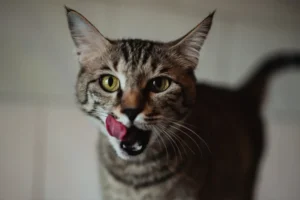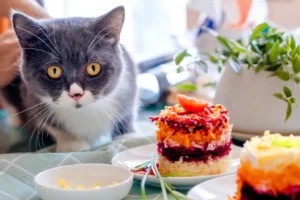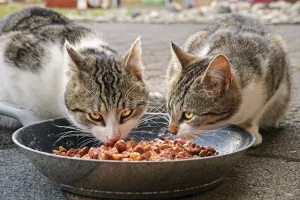Disclosure: We may earn a commission from helpful, relevant links in our content. No cost to you. See our privacy policy.
Feeding your feline friend can sometimes feel like a game of cat and mouse, especially with the vast selection of cat food on the market.
If you’re struggling with endless options or simply trying to find a more cost-effective solution, dry cat food might be worth considering. Our goal here is to provide you with an in-depth guide to dry cat food, exploring its benefits, potential drawbacks, and how it stacks up against its wet counterpart.
By the end of this post, you should be better equipped to make an informed choice, ensuring your cat’s nutritional needs are met while also catering to your convenience.
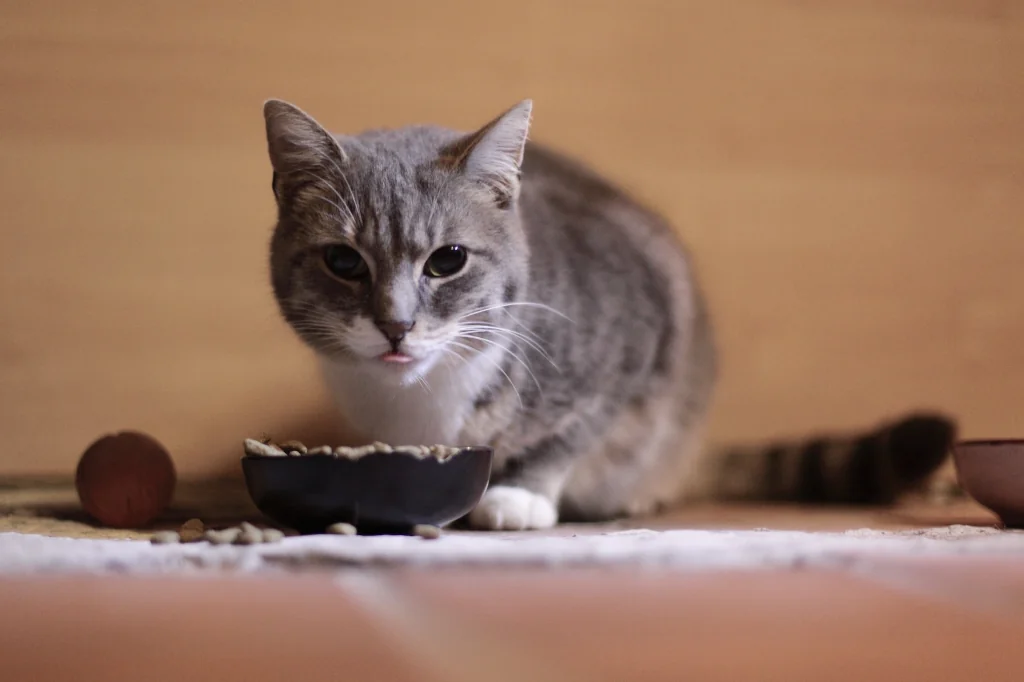
Why Consider Dry Food for Your Cat’s Diet?
Dry cat food, also known as kibble, offers several practical benefits that can make your life easier and potentially contribute to your cat’s health.
- Convenience. Kibble is easy to serve and store. Simply pour it into your cat’s bowl, and you’re good to go.
- Cost-effective. Generally, dry cat food is cheaper than wet food. This makes it a sensible choice if you’re catering to multiple felines or looking to cut down on pet expenses.
- Dental health benefits. Some brands of dry cat food are specifically designed to reduce plaque and tartar build-up in your cat’s teeth.
- Longer shelf life. Once opened, dry cat food can stay fresh for a longer period compared to wet food. This reduces waste and ensures your cat always has a ready meal.
In light of these benefits, dry cat food can be a practical, affordable, and beneficial option for your cat’s diet. But it’s not all sunshine and rainbows. Dry food does have some potential downsides that we will discuss next.
How Nutritious Is Dry Cat Food?
Cat products can have confusing ingredients. It can be difficult to understand what’s good and what’s not. In this section, we’ll break down the key components of dry cat food and shed light on what makes a dry cat food product nutritious.
Protein Levels: The Cornerstone of Cat Nutrition
Dry cat food can range in protein content from 30% to 40%, or even higher, depending on the quality. Protein is vital for all bodily functions, especially tissue repair and muscle growth.
High-protein diets are also crucial for weight control in cats as it helps to promote satiety.
When reviewing the ingredient list, ensure the source of protein is of high quality and preferably meat-based. Some premium brands even specify the type and quality of the meat used, such as:
- Deboned chicken
- Salmon meal
- Duck
- Turkey
Royal Canin Indoor Adult Dry Cat Food is a good example of this as it uses high-quality chicken as its main protein source, ensuring your indoor cat gets the protein it needs for a healthy lifestyle.
Avoid cat foods where meat by-products or unspecified meat meals are the main protein source.
Carbohydrate Content: Less Is More
In the wild, cats’ carbohydrate intake is minimal, which is normal for cats. But in dry cat food, it can range from 30% to 50% or more, due to the necessity of carbohydrates in the extrusion process of creating dry kibble.
But, high carb content can lead to obesity and diabetes in cats, so it’s advisable to choose brands that minimize carbohydrate content and focus more on protein and fats.
Grains like corn and wheat are often used as cheap fillers, so opt for brands that use healthier alternatives such as:
- Sweet potatoes
- Peas
- Legumes
Blue Buffalo Wilderness High Protein is an excellent option as it focuses on healthier carbohydrates and avoids grains.
Grain-free does not mean carb-free, so still keep an eye on the overall carbohydrate content.
Additives: Necessary Evil or Avoidable Annoyance?
Additives in dry cat food range from beneficial to potentially harmful.
Beneficial additives may include:
- Probiotics: Supports a healthy gut.
- Omega fatty acids: Promotes skin health.
- Taurine: Essential for heart and eye health.
Conversely, additives like artificial colors and flavors offer no nutritional benefits and should ideally be avoided.
Preservatives are a necessary part of dry cat food to increase its shelf-life. Natural options like mixed tocopherols (vitamin E) are much healthier than synthetic ones like BHA and BHT. Scan the ingredient list to ensure you’re comfortable with what your cat is consuming.
Essential Vitamins and Minerals: The Unsung Heroes of Nutrition
Vitamins and minerals make up a small, but incredibly significant portion of dry cat food.
From supporting immune health (Vitamin A) to facilitating metabolism (B-vitamins), these nutrients are crucial for your cat’s overall wellbeing.
Some essential vitamins and minerals found in quality cat foods include:
- Vitamin A: Supports immune health.
- B-vitamins: Facilitate metabolism.
- Calcium, Potassium, and Phosphorus: Maintains strong bones and a healthy heart.
- Trace minerals like Zinc, Copper, and Selenium: Support metabolic and immune functions.
Hill’s Science Diet Adult Indoor Cat Food is a product that ensures your cat gets these vital nutrients in its diet.
To learn more, visit our Guide on Essential Vitamins & Minerals
Remember, always consult with your vet for specific dietary needs of your cat, especially if they have health conditions. What’s most important is choosing a well-rounded, nutritionally balanced dry cat food that caters to your pet’s individual needs.
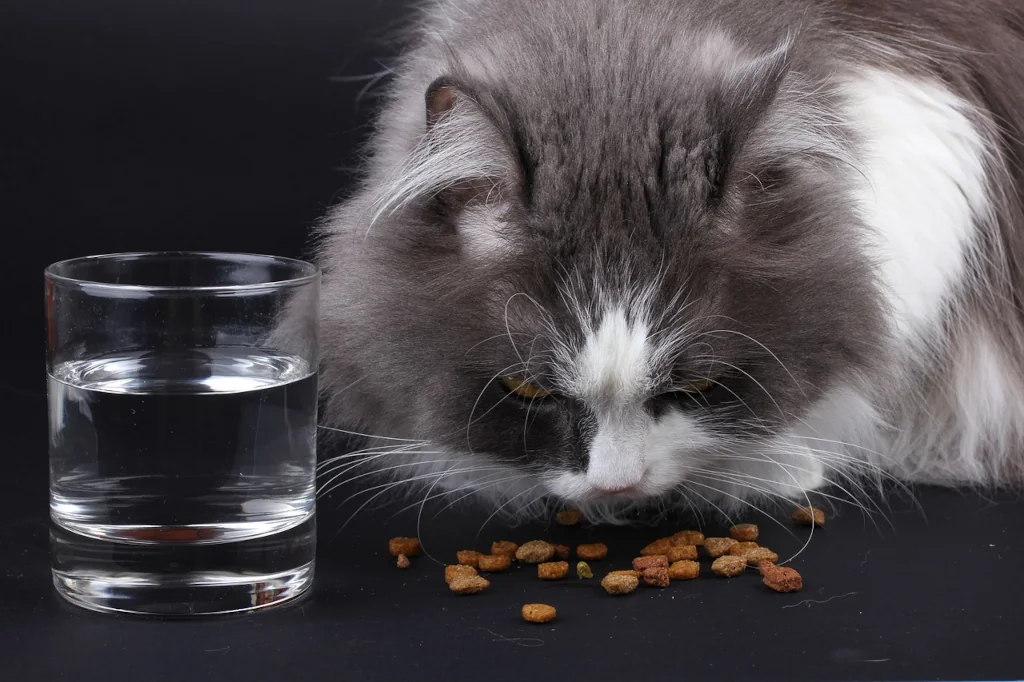
What Are the Cons of Dry Cat Food?
Dry cat food, while convenient and cost-effective, isn’t without its downsides. The two most prominent cons of dry cat food are:
- Low Moisture Content
- Possible Weight Gain
The most significant drawback of dry cat food is its typically low moisture content, hovering around 10%. Cats, by nature, are desert animals and rely heavily on their food for hydration. A diet exclusively based on dry food can potentially lead to dehydration and urinary tract health issues, including cystitis, urinary crystals, and even life-threatening urethral blockages.
In addition, as discussed in the previous section, dry cat food often has a higher carbohydrate content than a cat would consume in the wild. This can lead to weight gain and potentially diabetes if not monitored carefully. While there are low-carb dry foods on the market, they can be harder to find and more expensive.
However, weight gain does not typically occur with proper exercise and balanced nutrition, as one of the following studies in the next section showed.
Expert Opinions: What Do Vets Say About Dry Cat Food?
When it comes to veterinary opinion on dry cat food, the consensus isn’t entirely uniform. However, many vets do agree on certain aspects.
According to a study by the American Veterinary Medical Association, the primary concern with dry food is its low moisture content. Dr. Lisa Pierson, a renowned veterinarian, noted that cats on a diet of exclusively dry food might not drink enough water to compensate for the lack of moisture in their food, potentially leading to urinary tract issues.
On the other hand, research published in this study suggests that a cat’s diet significantly impacts oral health. Cats fed dry food tend to develop less dental calculus and plaque than those on a wet diet. However, a cat’s cheek teeth are more susceptible to poor oral health, regardless of diet. Despite dry food’s benefits in oral health, it doesn’t replace the need for a balanced diet, attention to nutritional value, and regular dental check-ups by a veterinarian.
A common misconception is that a dry food diet in cats is linked with an increased risk of developing diabetes mellitus. However, according to this study, it’s found that the proportion of dry food in a cat’s diet may not be an independent risk factor for the development of type 2 diabetes mellitus. Instead, the study highlighted that physical inactivity and indoor confinement are significant risk factors.
Therefore, maintaining an active lifestyle for your cat may be more critical in mitigating this risk than the type of food they consume.
Related: Choosing Dry Cat Food Guide
As with any significant dietary decisions, it’s advisable to consult your vet who knows your pet’s specific needs best. The key is to strike a balance that caters to your cat’s dietary needs, lifestyle, and personal preference.
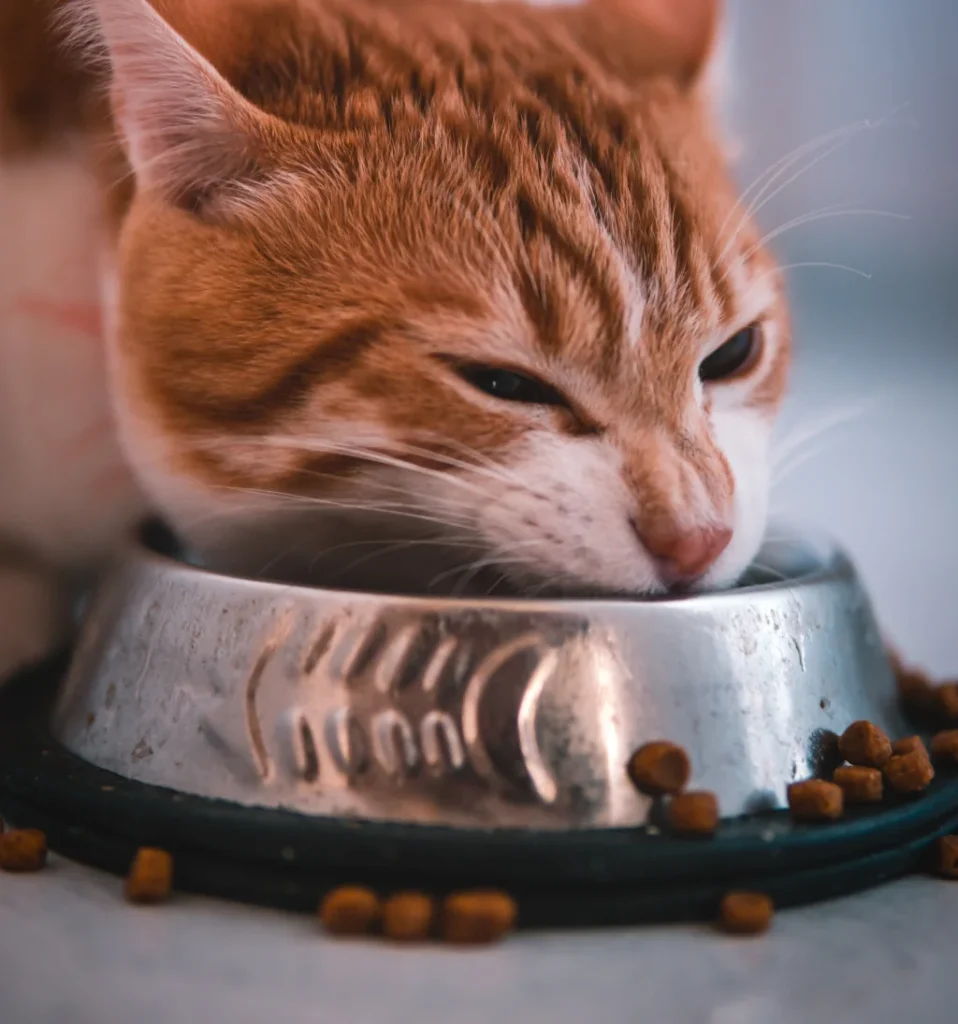
Commonly Listed Ingredients on Dry Cat Foods
You may not be familiar with some of the terms on dry cat food packaging, and understanding these can be a game-changer. So, here’s a quick reference guide:
- Taurine: An essential amino acid for cats, crucial for heart and eye health.
- Mixed Tocopherols: Natural, beneficial compounds often used as a preservative in pet food, derived from vitamin E.
- BHA/BHT: Butylated hydroxyanisole (BHA) and butylated hydroxytoluene (BHT) are synthetic antioxidants used as preservatives. They have raised health concerns and are generally best avoided.
- Meat Meal: Protein powder with a good source of protein, but the quality depends on the source animal.
- By-Products: These are non-meat parts from the animals, like organs and they are highly nutritious. However, the quality can be uncertain if the source animal isn’t specified.
- Corn Gluten Meal: This is a by-product of corn processing, mainly used as a cheap source of protein. It’s less nutritionally complete than animal proteins.
Suggested guide: Cat Food Labels and Guidelines
Dry vs Wet: Which One Does Your Cat Prefer?
While it’s tempting to choose one type, either dry or wet, remember that cats are notoriously finicky eaters, and no two cats are alike in their preferences.
While I’ll never forget my beloved Smokey’s penchant for dry food – he would always pick the dry nuggets first even when presented with an assortment of wet options – that’s not a universal norm.
His sister, Misty, on the other hand, was the exact opposite. She would daintily sidestep the crunchy kibbles and make a beeline for the wet food. There was that one time during a power outage; we ran out of her usual wet food supply. I was anxious, fearing she would go hungry. But to my surprise, she dove into Smokey’s dry food without hesitation. Since that day, I’ve always been an advocate for introducing variety in a cat’s diet early on.
The crux of the matter is, whether your cat prefers dry or wet food is largely a question of personal preference and past experience. But if your cat complete avoids dry food, consult our guide on what to do if your cat only likes wet food.
A diet that incorporates both types of food is often ideal. It combines the convenience and dental benefits of dry food with the hydration and high protein content of wet food, offering your furry companion a balanced and nutritious diet.
If you’re interested in reading more about this, check out our guide on dry vs wet cat food.
FAQs
What are the negatives of dry cat food?
Dry cat food often has low moisture content, which can lead to potential hydration and urinary tract issues if used without wet food. It also typically contains a higher amount of carbohydrates which, if not moderated, could contribute to weight gain and diabetes.
Is dry cat food good for cats?
Dry cat food can be a part of a balanced and nutritious diet for cats. It is convenient, cost-effective, and can aid in dental health. However, it should ideally be supplemented with wet food or ample water intake to compensate for its low moisture content.
How much dry food should I feed my cat daily?
The daily amount of dry food for a cat depends on several factors such as age, size, and activity level. Generally, an average adult cat requires about 200 calories per day, which equates to roughly 50-60 grams of dry food.
Should I mix dry and wet food for my cat?
Mixing dry and wet food can provide a balance between the dental benefits and convenience of dry food, and the hydration and high protein content of wet food. However, the proportions and frequency should be balanced based on your cat’s individual health needs.
Is it safe to feed my kitten dry cat food?
Yes, it’s safe to feed kittens dry cat food, but it should be specifically formulated for kittens, containing more calories, protein and certain essential nutrients than for adult cats. As a rule of thumb, kittens should stay on kitten food until they are one year old.
Alex, a passionate animal lover, has experience in training and understanding animal behavior. As a proud pet parent to two dogs and three cats, he founded AnimalReport.net to share insights from animal experts and expand his knowledge of the animal kingdom.

